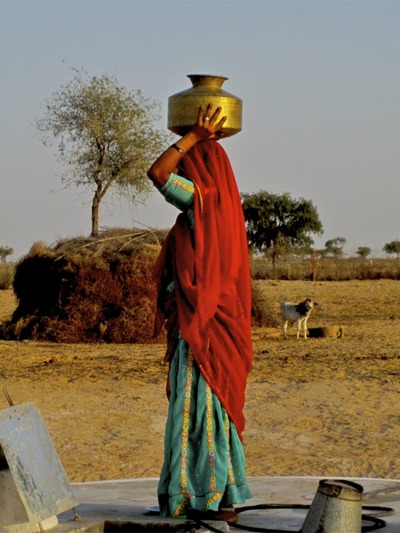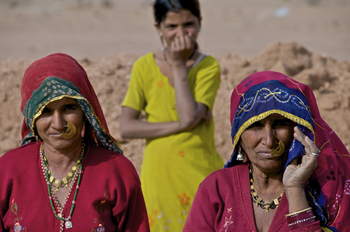words + photos by Barbara Aman
We arrived late at night at the field office of the nonprofit, a crumbling cement structure with a few rooms and a few rusted bed frames with torn, flattened pads. I was here to document the progress of a multinational water-supply project in this drought-challenged desert region in India’s western Rajasthan state. No luxury hotel here.
 Up before sunrise the next morning we first visited water catchment areas, where large areas were dug out a few feet down, the women wielding picks, the red dirt transported away with beat-up metal bowls by all available family members--typically grandparents and grandkids, who often worked together. The elder male stood at a distance, dressed in white--as if a maharajah from the past, leaning against his wooden cane--while the women, dressed in brightly patterned red saris, toiled behind him.
Up before sunrise the next morning we first visited water catchment areas, where large areas were dug out a few feet down, the women wielding picks, the red dirt transported away with beat-up metal bowls by all available family members--typically grandparents and grandkids, who often worked together. The elder male stood at a distance, dressed in white--as if a maharajah from the past, leaning against his wooden cane--while the women, dressed in brightly patterned red saris, toiled behind him.
It’s the women and girls who are most affected by the water shortage here. Many in the villages spend up to five hours a day walking to and from the closest well or storage tank, carrying water in their beat-up metal pitchers. Water for drinking, cooking, washing--it falls to them to fetch it, however far away it may be. Male/female roles are strictly cast here: Whatever it takes to keep the home and family running, it’s up to the females to get it done. At one point, Michael, my partner, had teasingly picked up one of the full water containers and placed it in my arms, and my legs almost crumpled. I could not imagine how these tiny women could carry these on their heads.
The next stop was a completed water catchment and storage area and as we drove up I could see the bright white paint job on the 12-foot round tank, jutting up about 2 feet from the ground, the lower half nestled tidily in the hard clay soil. A young woman stood atop it, quite shyly, covering her face with her tattered sheer sari while balancing her metal water jug adeptly atop her head. Her eyes seemed to bore through me, even in their shy state. She seemed as fascinated and curious about me as I was with her--how different our lives were, yet how intricately connected in some way. A few gentle words from the project director, whom she clearly respected, and her hand came away from her mouth, along with the sari. And below those steady dark eyes, I saw the glimmer of a smile in response to my broad one. Her dark eyes followed my every move, as I stood high and bent low to frame the best pictures.
The new “tanka” bore her name painted in yellow, the date it was commissioned, and the name of the village. She was a single mother with three young children and I could see in her eyes, and sense in my heart, a glimmer of belief in the fact that she mattered, that she had done something no other woman in her tiny village had ever done: attained a position of value and importance, one separate from the role she played in her extended family. Her no-nonsense expression seemed to say, “Yes, this is my life, this is my fate, this is how I am in the world. I am still one of many village women who live their lives for others. It is that way for me, as it had been for my mother, and for her mother before her.”
The project director explained that one of the keys to the success of the project was monitoring and managing the water collected in the storage tank. Since minute amounts of rain fell, even in good year, water was gold to them. How this water was used, once it landed in the storage tank, became the decision of the village. During the project’s initial stages, with men heading up the individual village committees, there were disagreements. The intent was for the villages to be self-sufficient and self-directing. Now, each village had chosen a woman who would manage their precious resource and this appeared to be working quite successfully. It seemed that women were able to balance the needs and requirements of the community as a whole more effectively and with less conflict than men. Cultural norms gradually and begrudgingly shifted.
Fascinated with the realization that this project had changed the cultural dynamic between men and women in these small villages, I asked if it were possible to meet with the women, with an interpreter.
The women and children met us as we arrived. As part of their ritual of welcome, we received a red thumbprint on our foreheads, some of which dribbled down the bridge of Michael’s nose, making it look like he had just been in an auto accident sustaining head injuries. But I seemed to be the only one who noticed. Colorful fake plastic leis (Chinese wares find their way into the most unlikely places) were placed around our necks.
The women, some girls, all had metal water jugs either on their heads or in their arms. We walked as a group to an area inside adobe walls painted with interesting white symbols. The cultural norms were clear in how the group assembled on the colorful woven mats. Groups of children (boys in front, and girls, who all seemed shy, behind), elder women behind them, older daughters, daughters-in-law hovered at the back, seeming unsure and not wanting to fully engage in the gathering. Large ornate nose rings hung from the pierced noses of the women, down past their lower lips, and I could not imagine how they functioned with these. How did they eat? How did they sleep?
 I noticed that some of the younger women, sitting in back, did not wear the large nose ornaments, instead sporting smaller nose hoops, not all that different from ones I see on the noses of young women their age back in the States. I had to ask.
I noticed that some of the younger women, sitting in back, did not wear the large nose ornaments, instead sporting smaller nose hoops, not all that different from ones I see on the noses of young women their age back in the States. I had to ask.
The matriarch answered. It was clear that, as the spokesperson, she held an air of authority leaving little doubt, from the tone of her voice, that she spoke for the group. “Our daughters say they don’t want to wear them. We tell them we want them to, but they refuse.” Teenager rebellion exists everywhere, I guess. These young women were finding their voices. They were learning to say what was true for them. All of them, all of these hard-working, dedicated women of all ages, were finding a way through this new and changing world of diminishing resources, and learning how to shift yet strengthen relationships with each other, with the men in their families, and with all in their communities.
Barbara Aman considers herself a world citizen, and when not living in, traveling through, and photographing diverse countries and cultures, she does marketing and teaches dance in Santa Rosa, California. Her interest in and support of women and children is a thread that weaves through all parts of her life, all parts of the globe.



